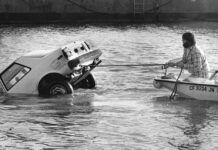In the middle of the night in January of 1984, before eastbound “H” Street opened up from I-805, the fire department extinguished a car fire in the dirt area. Once firefighters put out the blaze they saw a charred body in the front passenger seat.
The vehicle was registered to a man living in southeast San Diego. As the medical examiner’s personnel placed the body into their van I told my partner, Tom Maloney, “I bet they find a bullet in the head.”
An inventory of the vehicle’s contents and the surrounding area yielded only a gas can outside the vehicle. There was no gun.
No one answered the door of the vehicle’s registered owner. Later that afternoon the medical examiner located a bullet in the head and determined the body was that of a male. We contacted the family of the registered owner to learn who his dentist was. Dental records days later proved that the owner of the car was indeed the homicide victim.
We checked area hospitals to see if anyone had arrived with burn injuries. Fireballs shooting outward often happen when people use gasoline to torch a confined space like a car. No one had come in with burns.
The deceased was black and was not married. We learned he was a small-time marijuana dealer. The amounts he bought and sold normally wouldn’t be enough to merit a killing.
A search of his residence and listening to his answering machine yielded no help. We eventually contacted everyone in his address book with no useful results. His life was secretive, even to his family.
About 8 o’clock that first night we were sitting in our office summarizing everything that happened, making sure everyone working the case knew what everyone had done that day.
The victim’s sister came to the station. At this time we didn’t have confirmation from dental records on his identity, but we knew in our investigative hearts who he was. The sister was a tall, attractive black woman. She had graduated from an Ivy League school, was employed, and lived in San Diego.
We probably looked haggard, having been working about 16 hours by now, nourished by apples, coffee, and granola bars. Maloney had soot on his hands, face, forehead, and ears from working inside the charred car looking for evidence. The sister eyed our scruffy presence with disdain as we explained what we knew and what we had done. She had no recent contact with her brother. She looked at me and sneered, “Don’t you have any black detectives?”
The bad Tom Basinski wanted to say, “Well, we can send Maloney back to work inside the car for a while and he could very soon pass for one.” But for once I kept my mouth shut. I told her we didn’t. Her unspoken implication was that these white boys didn’t know how to talk to black people.
The next day I contacted another agency and asked if a black detective could help us from time to time. The irony was that the black detective who dealt with her wasn’t real sharp, polished, or industrious. I wonder what that Ivy League woman thought of him.
My usual stance is that I give a free pass to families of a homicide victim because of their loss. They can say what they want, including criticizing the investigation.
For the racism exhibited toward us by the victim’s sister, I should have put her in her place right away. I’m glad I didn’t though because “it” would have hit the fan.
To my regret we never solved that case, even with the help of a black detective. Racism runs both ways, and that scenario proved it.
Basinski was a homicide detective for the Chula Vista Police.











